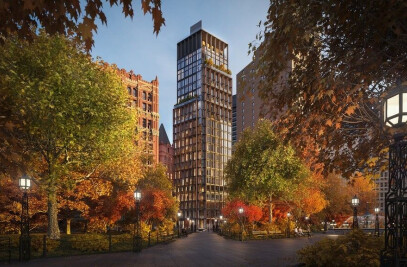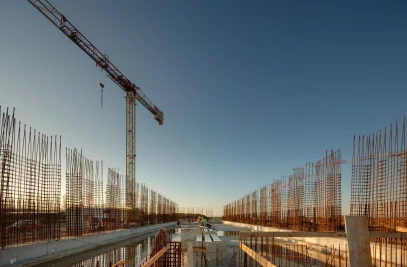This scheme lies in the heart of the Bankside area of London, where a wide range of cultural, business and residential communities and a diverse and thriving built environment have co-existed in an intricate web of streets dating from medieval times. The site is located close to the River Thames and is directly opposite the west entrance to the Tate Modern and the site of the proposed extension to the museum.
The development will provide 229 residential units in five separate buildings ranging from six to 24 storeys. The total residential provision of the scheme covers 28,600 m², with retail units provided at ground level with a total area of 1,044 m² and additional storage in the basement. Southwark Council granted planning permission for the development in June 2007. Site clearance and preparation was completed during 2008 and work has started on the first phase.
Concept
The Bankside area is one of the oldest parts of Southwark. Once an important centre for entertainment venues in the 16th and 17th centuries, the area has recently seen tremendous change and regeneration, encouraged by developments such as Tate Modern, the Globe Theatre and the Millennium Bridge.
The site occupies a complex, irregular space between Southwark, Sumner and Holland Streets, with particular urban constraints in an area of transition ranging from the large volumes and heights of Tate Modern and the Bankside 1/2/3 office development to a series of adjacent, listed two-storey almshouses.
The brief was to design a modern landmark scheme which will provide a high quality residential element within a vibrant mixed-use development. It also required that the design established a positive relationship to its context and, in particular, to its immediate neighbour, Tate Modern and the proposed extension. The site is typified by an inconsistent urban grain with poorly defined street edges. The proposal provides an opportunity to significantly improve links between Southwark, the Thames and Tate Modern.
RSHP’s response seeks to link the diverse scale of the surrounding buildings, and address the urban grain whilst reinforcing the street edges to provide greater definition between the site and surrounding streets.
The configuration of the buildings fronting onto Southwark Street creates the possibility of a new ‘marker’ for the area, helping to ‘signal’ the main approach to Tate Modern and the opportunity for north/south permeability through the site. Moving the mass of the buildings away from Southwark Street as well as from the almshouses, helps to mediate between the differential in scale - the five individual buildings step in height in response to the neighbouring properties. The grain of the development encourages permeability and public connectivity through the site, further animated by retail uses. The resulting public realm extends the landscape themes from Tate Modern’s own local environment resulting in a more consistent physical environment than currently exists. The proposal also complements and extends the ground level activities contained in Bankside 1/2/3 and provides a soft, landscaped backdrop to the almshouses.
Design
The development will provide a total of 229 residential units in five separate buildings, ranging from six to 24 storeys. The buildings, designed by Rogers Stirk Harbour + Partners, are four diamond-shaped glass and aluminium pavilions and one roadside corner block as part of the development of the Bankside area. The vibrant mixed-use plan is located in an unrivalled location adjacent to the famous Tate Modern near the River Thames, upon historical streets that date back to medieval times. The NEO Bankside scheme is described as having quality façades with expression and depth. “The form and structure of the buildings create the controlling framework for this range of cladding types, and together form a strong visual identity to the façade” – Rogers Stirk Harbour + Partners. The visually striking appearance was achieved with a unique external structural bracing and a facade comprised of timber and clear glazing. RSHP removed the need for internal structural walls, thereby creating “highly flexible internal spaces”. Displaying the load-bearing structures is a characteristic of RSHP and their practice of “the demystification of services”. External glass lifts also add a contemporary characteristic to the buildings. Upon completion, the five separate buildings will step in height, ranging from 12 to 24 storeys and comprising of 229 residential units. Wintech provided comprehensive facade engineering consultancy services on this remarkable project, assisting in the successful formation of the unique building skins that exhibit the structure on the outside. Carillion were awarded the role of main contractor. Neo Bankside was awarded International Winner in the Best Development category at The International Property Awards 2011.
The units vary from studios to four-bedroom penthouses. Of these units, 32 are shared equity, with a substantial provision of affordable housing to be provided in the London Borough of Southwark on a separate site. The total residential provision of the scheme covers 28,600m2.
Retail units will be provided at ground level, with a total area of 1,044m2. A common concierge for all blocks is located at the focal point of the scheme at the base of the tallest building. A single-storey basement runs beneath the entire site in which additional storage is provided.
The hexagonal plan form and orthogonal structural grid offer flexibility in the planning of the internal layouts. The brief required a range of apartment sizes from studios and one-bedroom to four-bedroom units, each of varying sizes. Penthouses are larger duplex units, expressed as independent pavilion structures, which take advantage of the sloping roof plane with double-height living areas. Winter gardens at the north and south ends of each building create ‘prows’, reinforcing the buildings’ relationship to Holland and Sumner Streets.
Views in and out of the apartments are controlled and directed by the cladding system. The use of timber louvred screens provide privacy by directing views away from neighbouring buildings both within and outside the development. These screens also provide solar shading for the apartments, reducing solar heat gain.
The proposal seeks to achieve a contemporary architectural language which responds creatively to, and mediates between, the articulation and colouration of the local architectural context. The area surrounding the site is characterised by the variety of the scale and style of its buildings. This variety extends to the materials used, ranging from the warm brick hues of the Victorian buildings on Southwark Street and Tate Modern to the precise steel and glass of Bankside 1/2/3 These materials also reflect the changing historic use of the area, from predominantly industrial activity to cultural, office, residential and retail uses.
Project Bankside is conceived as having quality façades with expression and depth. The external bracing is located proud of the façades and adds visual depth to them. The façade aesthetic is softened through the use of solid and timber louvred elements, both within and behind the glazing. The timber louvres are set between the layers of the double glazed façade and the use of solid, insulated backing panels continues the warm colouration. The organisation of the clear louvred and solid panels within the façade reflects the internal organisation of the apartments. The form and structure of the buildings create the controlling framework for this range of cladding types, and - together - form a strong visual identity to the façade.


































